CDC- Interim Guidance about Ebola Virus Infection for U.S. Citizens Living Abroad
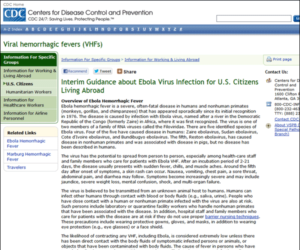 Viral hemorrhagic fevers overview; CDC recommendations; what to do if you think you have been infected; what to do after you return.
Viral hemorrhagic fevers overview; CDC recommendations; what to do if you think you have been infected; what to do after you return.
 Viral hemorrhagic fevers overview; CDC recommendations; what to do if you think you have been infected; what to do after you return.
Viral hemorrhagic fevers overview; CDC recommendations; what to do if you think you have been infected; what to do after you return.
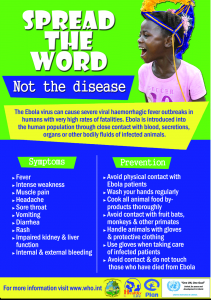 The poster has information about how the virus is transmitted from animals to humans. The audience is Liberian communities where introduction of the virus from bushmeat is a primary danger. The poster is clear, bright, and understandable.
The poster has information about how the virus is transmitted from animals to humans. The audience is Liberian communities where introduction of the virus from bushmeat is a primary danger. The poster is clear, bright, and understandable.
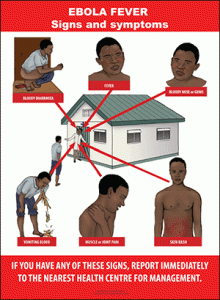 This poster shows the signs and symptoms of Ebola fever through illustrations. Anyone with the symptoms is encouraged to go to a health centre.
This poster shows the signs and symptoms of Ebola fever through illustrations. Anyone with the symptoms is encouraged to go to a health centre.
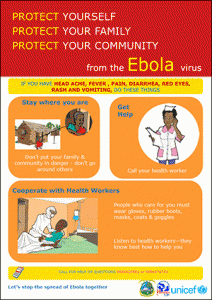 This poster’s audience is the general community in Liberia and has information on protecting yourself and your family, and steps to take to seek care. It has clear calls to action, is well-designed, and the use of graphics makes it appropriate for low-literacy populations.
This poster’s audience is the general community in Liberia and has information on protecting yourself and your family, and steps to take to seek care. It has clear calls to action, is well-designed, and the use of graphics makes it appropriate for low-literacy populations.
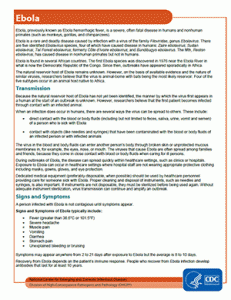 Find out how Ebola is transmitted and its signs and symptoms.
Find out how Ebola is transmitted and its signs and symptoms.
 Follow this link to a set of 7 radio messages in different languages (English, French, and 11 other languages). Radio messages include spots on prevention, risk, and stigma. Transcripts are included. These spots will be most useful when read by a local voice and adapted for local dialect and context.
Follow this link to a set of 7 radio messages in different languages (English, French, and 11 other languages). Radio messages include spots on prevention, risk, and stigma. Transcripts are included. These spots will be most useful when read by a local voice and adapted for local dialect and context.

The Ebola Communication Network was originally developed by the Health Communication Capacity Collaborative (Cooperative Agreement #AID-OAA-A-12-00058) and expanded under Breakthrough ACTION (Cooperative Agreement #AID-OAA-A-17-00017) both under the leadership of Johns Hopkins Center for Communication Programs. This website is now maintained by Johns Hopkins Center for Communication Programs and its contents are the sole responsibility of CCP. The contents of this website do not necessarily reflect the views of USAID, the United States Government, or Johns Hopkins University.
